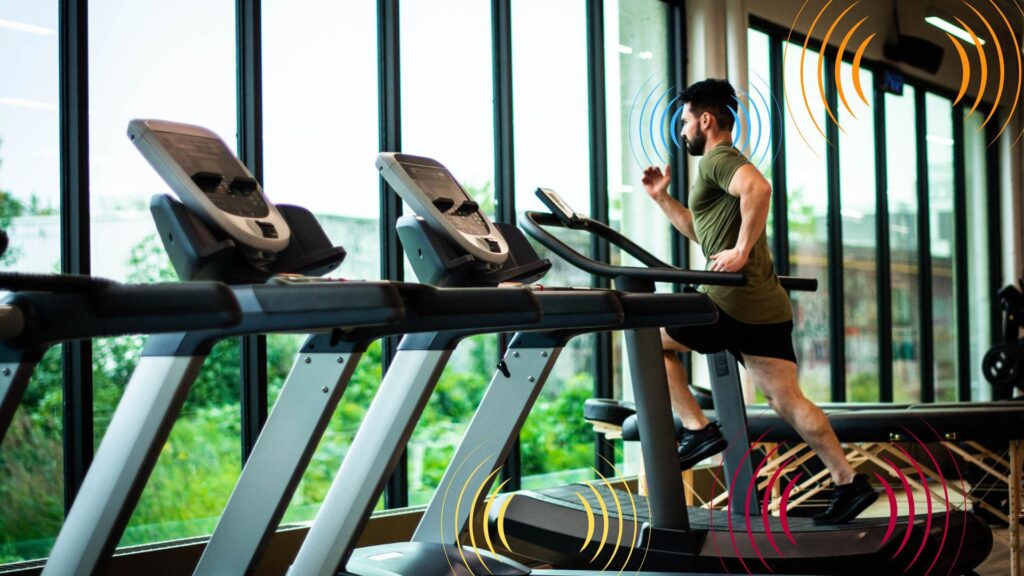Top Factors Contributing to Noise Generation in a Gym (Intro)
Noise in a gym can come from many different places. Before undertaking hasty measures to soundproof your facility, you must consider the source of the problem. What are the 3 factors that influence noise generation in a gym?
In the following examples, we will learn about the best (and worst) materials to control noise in your gym. Furthermore, we’ll review what characteristics your building may have and how these can favour or hinder the generation of noise. Finally, we will see how sound and vibrations propagate through the different rooms.
Construction Materials
When embarking on a gym-building project, it won’t usually be our choice of construction materials for the floors and walls. Along with the ceilings, these form the existing building unless we are building the premises ourselves. Now, does this mean that we cannot change anything? More or less.
With the floors, your facility likely has a concrete floor or other material that makes it difficult to reduce noise. In such cases, consider installing a durable, cushioned floor. A good option is rubber flooring: the most widespread due to its economic price and great durability. If you are looking for something different, wooden flooring offers acoustic advantages with a more elegant finish.
Walls can be another headache when it comes to soundproofing a sports or fitness facility. If you are creating a gym from scratch, you’ll be able to prevent excessive noise with specific-purpose materials. For example, acoustic foam spray can be installed in wall cavities to drastically reduce noise.
As for the ceilings, we can apply the principles mentioned above. Additionally, there are certain materials widely used due to their acoustic properties. Perhaps one of the cheapest and most effective is plaster, but you may want a different finish for your gym. The use of fibreglass is also highly recommended for the internal ceiling cavity, allowing surface decoration to your liking.

Building Features
In determining how to soundproof a facility, the first step is to know the makeup of the building. That is, how it is divided internally, its construction materials (if it’s an existing building), and what adjoins the premises.
The context of the gym is one of the key factors in assessing noise. We often think of the sports centre as creating a nuisance to the neighbours. But what if our “neighbours” are a dance academy and a busy building site? In this case (and in less extreme cases), noise bleeds in from outside. It is smart to identify the source of noise in advance and thoroughly soundproof the surface closest to it.
Regarding the internal aspects, we must determine whether we want a layout which is completely open, compartmentalised, or mixed. How we approach the laborious task of soundproofing a gym facility will depend on this choice. For an open and spacious gym, we should soundproof all possible flat surfaces to tame the spread of noise.
If, however, you want to divide your facility into different zones, you’ll have to consider noise from each zone. It is common to offer different activities in your gym, such as spinning, Zumba, or body combat. Many of these activities will generate noise, while others, like Pilates, will require a more peaceful environment. It’s smart to invest in insulating partitions to prevent the transmission of noise into, and out of, these areas.
Sound and Vibration Propagation
It is not our goal to teach acoustic physics here. But you will benefit from some basic knowledge to help you understand noise generation in a gym. Without going into too much detail, this is caused by acoustic reflection. I.e. The reflection of sound and vibrations on flat surfaces, which can even be amplified depending on the surface material.
To avoid this problem, the most widely used solutions are sound absorption materials. When sound waves come into contact with these surfaces, they reflect off, but with a much lower intensity. In this category, we find insulating materials such as polyurethane foam (copper) or fibreglass.
Alternative absorbent materials also have sound diffusion properties. These are characterised by reflecting the original sound wave in multiple directions, weakening its acoustic power along the way. These materials are easily characterised by the use of geometrically shaped surfaces, such as pyramids or cubes. The properties of diffusing materials are more suited to other contexts, such as a recording studio. However, in combination with absorbent materials, the results can be outstanding.
Conclusion
You should now know why, and how, noise is generated and propagated in your fitness or sports centre. When assessing the construction materials used or the characteristics of your building, you’ll be able to make a smart decision about soundproofing your gym.
To comment on the article, please proceed to the Telegram post. We encourage you to read our comprehensive article “How To Choose Gym Flooring“.
Disclaimer: The opinions and positions expressed in this publication are those of the authors and contributors and do not necessarily reflect the views and policies of the professional fitness community.

